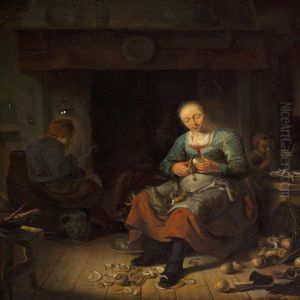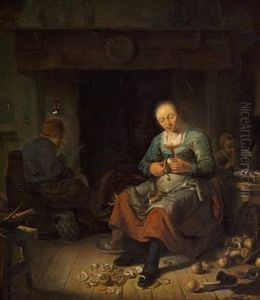Isack De Mes Paintings
Isack de Mes, also known as Isaack de Moucheron, was a notable figure in the Dutch Golden Age of painting, born in 1615 in Emden, Northern Germany, but his work and life are primarily associated with the Netherlands. His artistic journey is emblematic of the era's vibrancy and the cross-pollination of cultural and artistic ideas across Europe. De Mes's family moved to Amsterdam when he was young, a city that became the epicenter of his artistic development and output.
Isack's father, Frederick de Moucheron, was also an artist, specializing in landscape paintings, a tradition that Isack would not only inherit but also expand upon. The Dutch Golden Age was a period of great wealth and cultural achievement for the Netherlands, and landscape painting was one of its most significant artistic expressions, reflecting the Dutch people's appreciation of nature and their land.
De Mes is particularly known for his detailed and atmospheric landscape paintings, which often depicted idyllic scenes with meticulous attention to the elements of nature and architecture. His works are characterized by their delicate light, precise detail, and the serene harmony of natural compositions. These paintings not only showcase his technical skill but also his ability to capture the essence of the Dutch landscape and its changing seasons.
Throughout his career, Isack de Mes traveled extensively across Europe, drawing inspiration from various sources and integrating different stylistic elements into his work. This included a significant period in Italy, where he was influenced by the Italian landscape and light, elements that he skillfully blended with his native Dutch sensibilities. His travels and experiences enriched his palette and broadened his thematic range, incorporating classical ruins and Mediterranean vistas into his compositions.
De Mes's contribution to the Dutch Golden Age of painting is significant, not only in terms of his artistic achievements but also in his influence on subsequent generations of artists. His work reflects the period's broader cultural and artistic trends, where an appreciation of the natural world, a sense of national identity, and a keen interest in the detailed observation of the environment were paramount. Isack de Mes died in 1673, leaving behind a body of work that continues to be appreciated for its beauty, technical excellence, and historical value. His legacy is a testament to the enduring appeal of Dutch landscape painting and its ability to capture the transient beauty of the natural world.




